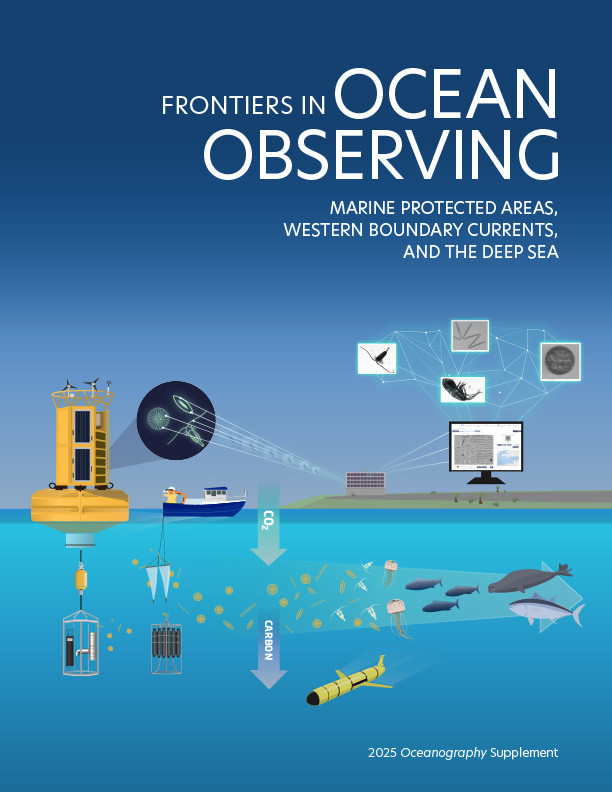Full Text
In this third and final “Frontiers in Ocean Observing” supplement to Oceanography, peer-reviewed articles describe data collection and analysis from the surface ocean to the seafloor, spanning the globe from marine protected areas to western boundary currents and the deep sea. They describe a variety of technologies used to collect and analyze ocean observations, including emerging sonar technology for high-resolution mapping and imaging of the seafloor, low-cost tools combined with artificial intelligence to monitor blue carbon in Greenland’s deep sea, and the integration of eDNA, acoustic, and trawl data to investigate the diversity, abundance, biomass, and distribution of micronekton in the Western Indian Ocean.
Other articles describe how autonomous vehicles such as gliders now assist with management of marine protected areas, detection and protection of North Atlantic right whales, forecasting of harmful algal blooms, investigation of marine heatwaves, and augmentation of the network for ocean animal tracking. They also detail, for example, how ocean scientists are obtaining long-term data on western boundary currents to augment other more traditional data collection methods with approaches that include partnering with a merchant marine container vessel to collect data on the Gulf Stream and a collaborative project between researchers and industry that uses commercial fishing gear to collect subsurface ocean data in the East Australian Current. Another article considers how the observations collected in western boundary currents, in particular, the East Australian Current, impact ocean forecasts, a useful assessment for improving ocean observing system design.
Similar to the first two ocean observing supplements (see https://tos.org/ocean-observing), we invited potential authors to submit letters of interest associated with topics aligned with the priorities of the UN Decade of Ocean Science for Sustainable Development (2021–2030). The chosen topics for this supplement are described below.
Model-Based Design and Evaluation of Observing Networks
Here, the authors describe and apply model-based methods for methodically evaluating existing integrated ocean observing systems and future extensions by exploring process-focused array design, observation priorities, and sampling strategies; complementarity versus redundancy of multi-platform networks; and detectable changes in key climate metrics.
The Use of Autonomous Tools for Ecosystem Management and Monitoring of Marine Protected Areas
Authors addressing this topic demonstrate how sensors on autonomous vehicles are filling critical gaps in ocean biological and spatial conservation knowledge that will help tackle ecosystem-level challenges caused by global environmental changes.
Western Boundary Currents and Their Impacts on Shelf Seas
These articles showcase long-term, sustained observational efforts in western boundary current shelf sea regions that highlight strengths, weaknesses, and gaps in the system, and/or provide examples of end-user and stakeholder engagement.
Technological Solutions for an Accessible Deep Ocean
This section provides recent examples of how the intersections among cutting-edge sensors, including low-cost technologies, data analytics, and robotics, are advancing deep-sea exploration and opening avenues for discoveries and a deeper understanding of our planet’s least-explored realms.
Many thanks to Ocean Networks Canada, the US National Oceanic and Atmospheric Administration’s Global Ocean Monitoring and Observing Program, and the Partnership for Observation of the Global Ocean for generously supporting publication of this supplement to Oceanography. I would also like to thank all the supplement’s guest editors for their valuable input and guidance on articles submitted to their thematic areas.

